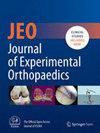Genetics, sex and the use of platelet-rich plasma influence the development of arthrofibrosis after anterior cruciate ligament reconstruction
Abstract
Purpose
To identify genes and patient factors that are related to the development of arthrofibrosis in patients after anterior cruciate ligament (ACL) reconstruction and to develop a prognostic model.
Methods
The study included patients diagnosed with ACL injury who underwent ACL reconstruction. Patients were enroled consecutively and divided into non-fibrotic (controls) and fibrotic (cases) groups until a balanced sample of matched case–control was achieved. Arthrofibrosis was considered pathological if the range of motion achieved 3 months after surgery decreased by at least 25% compared to its initial full range of motion. Patient variables and saliva samples were collected from each patient to perform a genetic approach by screening a set of candidate genes implicated in arthrofibrosis. Chi-squared was used to analyze the association between the development of arthrofibrosis and different independent variables. Binary logistic regression was used to develop a prognostic algorithm.
Results
A total of 45 controls (non-fibrotic patients) (50.1%) and 44 cases (fibrotic patients) (49.9%) were included for analysis. The median age was 34.0 years (95% confidence interval = 29.0–38.0) and the number of women was 32 (35.9%). Seven genetic polymorphisms showed significant association with the development of arthrofibrosis (p < 0.05). After binary regression analysis, the regression model included the polymorphisms rs4343 (ACE), rs1800947 (CRP), rs8032158 (NEDD4) and rs679620 (MMP3). This analysis also indicated that female gender was a risk factor while the use of platelet-rich plasma (PRP) during surgery was a preventive factor (p < 0.05).
Conclusion
Genetic alterations involved in inflammation and extracellular matrix turnover predispose to the development of arthrofibrosis after ACL reconstruction. Female sex was a risk factor in the development of this condition, while the application of PRP provided a preventive effect. The combination of patient and genetic variants of a patient allows the development of a prognostic algorithm for the risk of post-surgical arthrofibrosis.
Level of Evidence
level III.


 求助内容:
求助内容: 应助结果提醒方式:
应助结果提醒方式:


